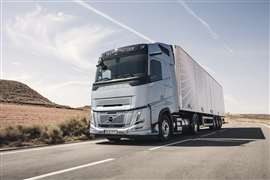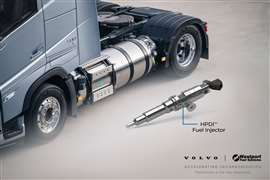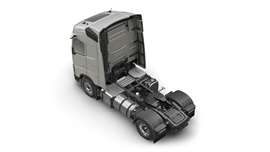Read this article in French German Italian Portuguese Spanish
How compression ignition works in gaseous-fuel engines from Volvo Trucks
28 July 2025
Use of LNG and CNG usually means spark ignition, but Volvo Trucks has gone down a different route to achieve improved fuel economy, reports Julian Buckley
 Gas-powered Volvo FH Aero (All photos supplied by Volvo Trucks)
Gas-powered Volvo FH Aero (All photos supplied by Volvo Trucks)
Volvo Trucks has models featuring hydrogen fuel cell powertrains in development, but the Swedish company has already introduced variants of its FM, FH and FH Aero trucks with engines powered by liquified natural gas (LNG) and bio-LNG. These engines offer similar on-road performance to their diesel equivalents, but with reduced CO2 emissions and a series of other advantages.
In an exclusive interview with Power Progress International, Daniel Bergstrand, product manager for Volvo Trucks, shared details about the technology developed to support the use of LNG and bio-LNG in the company’s heavy-duty truck ranges, comprising models in excess of 18 tons GVW.
 Daniel Bergstrand, Volvo Trucks
Daniel Bergstrand, Volvo Trucks
Bergstrand: “In 2007 we showcased seven different driveline prototypes, including biodiesel, biogas, biogas/biodiesel, DME, ethanol/methanol, synthetic diesel and hydrogen/biogas. We did this to illustrate the different routes to achieving CO2 reductions. Today, we have diesel, supporting biodiesel and HVO, LNG and battery-electric drivetrains. Looking at vehicles with diesel and LNG engines, they are essentially the same truck; there’s virtually no difference apart from the engine.”
But what a difference. It might be suspected that changes to the D13 diesel engine to support use of LNG would centre around the fuel injection and combustion systems – and that would be correct. The high-pressure direct injection (HPDI) system needed to deliver the gaseous fuel was developed by Canadian company Westport Fuel Systems (a JV between Volvo Trucks and Westport named Cespira was later formed to commercialise the HPDI system).
To support a compression combustion model more commonly used with diesel engines, Westport also developed a new injector that uses concentric needles to deliver both a very small amount of diesel fuel (or HVO) and natural gas into the combustion chamber. As the cylinder rises and the pressure builds the diesel droplets ignite, which in turn burns the gaseous fuel to achieve full power.
 HPDI fuel injector developed by Westport Fuel Systems
HPDI fuel injector developed by Westport Fuel Systems
With more than a little Scandinavian understatement, Bergstrand offers some additional detail. “These technologies are a bit different from other engines which use LNG. The pilot [diesel] fuel, which is about 7% of the total used in each cycle, allows us to use the compression cycle and that high-pressure model gives us similar power and fuel efficiency of a diesel engine.”
Fuel delivery
The HPDI system is a complex yet elegant solution that supports use of LNG in an internal combustion engine. But the system which brings the fuel to the engine is equally well designed, with uniformity of delivery the overarching goal.
A cryogenic pump located in the isolated vacuum tank holding the LNG at about -140ºC increases the pressure of the liquid fuel to the required 300 bar (4,350 psi). At the top of the pump a vaporiser converts the LNG to CNG before it is delivered to the integrated gas module (IGM) to achieve the correct temperature and pressure. From the IGM, the fuel is directed to the gas conditioning module for a final pressure adjustment before delivery to the HPDI system and the injection event.
At engine shutdown the gas shutoff valve is closed and any remaining fuel in the injectors and gas rails is vented. This is done to ensure the correct pressure in the injector’s gas needles when the engine is restarted. To prevent unnecessary loss and venting to the atmosphere, a return-to-tank module directs any remaining gas back to the holding tank.
Diesel fuel in a standard engine acts as both a coolant and a lubricant – the LNG fuel cannot act as a lubricant simply due to its physical composition. But Bergstrand says that there’s no need for any additional lubricant beyond the engine oil.
 Volvo FH with cryogenic tank (left-hand side) for LNG fuel
Volvo FH with cryogenic tank (left-hand side) for LNG fuel
It might be expected that the very little diesel fuel used in the combustion event would result in less soot being distributed around the engine and captured in the oil, which might translate to an extended service interval. But Bergstrand says that the LNG engine has a similar service schedule to that of a diesel model.
Without wanting to put forward a specific number, Bergstrand agrees that a there is a “significant percentage” of components carried over from the base diesel engine. But that could be more of a benefit than a drawback; commonality between the LNG and diesel engines will likely help with maintenance when on the road.
One of the drawbacks to using hydrogen as a fuel, particularly in internal combustion engines, is the detrimental effect the fuel has on components, a process known as embrittlement. Bergstrand explains that with almost no interaction with existing engine parts, LNG does not have the same negative effects as hydrogen.
“The fuel systems are designed specifically for use with LNG, so that has been taken into account. For example, the pipework used to carry the fuel is metallic, which also helps to maintain pressure in the fuel system,” he adds.
Market acceptance
According to Eurogas, a regional association which represents companies working in the gas value chain, there were more than 800 LNG refuelling stations across Europe as of July 2025. Germany had the most with 195 locations, followed by Italy (173), Spain (105) and France (91). Companies such as Gasrec and Calor Gas are working to create an LNG supply network for heavy trucks in the UK.
Bergstrand says that market interest in LNG trucks varies by region, but also by customer use case. “Infrastructure to support trucks makes a huge difference,” he explains. “That said, I’ve not heard of a driver who tried our LNG truck and did not enjoy the performance.”
He reports that drivers compare the driving experience of an LNG-fuel truck to that of a diesel, particularly in terms of on-road performance and driving range (which translates directly to fuel economy). According to Volvo Trucks, the LNG truck variants have a range of about 1,000 kilometres with a full fuel load.
 Refuelling with LNG
Refuelling with LNG
Of course, refuelling is a little different. Instead of a standard fuel nozzle, a ring clamp is used to connect the refuelling hose to the holding tank. Volvo Trucks have a pressure gauge on the tank to allow monitoring of the internal pressure. Venting during refuelling might be necessary, but where other OEMs have separate vents, Volvo Trucks locates that escape valve in the refuelling system. “We think there’s a benefit, as there’s one less connection point. It makes the refuelling process more similar to diesel,” says Bergstrand.
Another benefit of LNG is that it’s highly unlikely that ‘bad’ fuel will be dispensed. Diesel fuel can be adversely affected by water, particularly in poorly maintained storage tanks. Using this contaminated diesel can affect engine performance and damage pumps or other components. The LNG production process (see box) effectively removes water and other impurities, leaving what should be very close to pure liquid fuel.
Counting future cost
As might be expected, trucks with LNG engines are more expensive than those with diesel powertrains. “New technology generally results in added cost,” says Bergstrand by way of explanation. That said, any additional spend could be reclaimed through a favourable total cost of ownership – UK-based Gasrec said that LNG can be between 20 and 40% less expensive than diesel fuel, a noteworthy difference should that remain accurate.
Bergstrand estimates that production of vehicles with LNG engines at Volvo Trucks makes up about 2% of total volumes. But he says that the company is expecting that figure to increase – in fact, he says that it needs to increase. “This is a very important step in emissions reduction,” he emphasises. “Using bio-LNG can reduce well-to-wheel CO2 output to nearly 100%. There’s also the point that electric trucks will not be a suitable solution for every application and that’s where LNG will offer an alternative low-carbon solution.”
For a final word, Bergstrand highlights that no matter the current market interest, Volvo Trucks will be offering LNG-powered trucks for the foreseeable future.
“Some people speak of LNG trucks as if they are a transitional technology. We don’t think of them like that. We think this is part of the solution for the future, the capability to operate using renewable fuels. It’s a key part of our three-prong strategy where trucks using battery-electric, hydrogen fuel cell and internal combustion engines running on renewable fuels such as bio-LNG and hydrogen will support our company’s and our customer’s net-zero goals.”
LNG truck sales on the increase
 Volvo FH Aero - drivers like the similarity between driving diesel and LNG trucks
Volvo FH Aero - drivers like the similarity between driving diesel and LNG trucks
In May 2025, Volvo Trucks reported growing demand for its models with LNG and bio-LNG engines, with more than 8,000 units sold around the world.
Top markets for the gaseous-fuel trucks were Sweden, Norway, the Netherlands, Spain and the UK.
“Many of our customers choose to replace their diesel trucks with gas-powered trucks as an easy way to reduce their CO2 emissions here and now,” said Jan Hjelmgren, head of Product Management at Volvo Trucks.
He continued: “Volvo’s gas-powered trucks are a real win-win for transport companies as they can combine a lower cost of ownership with a reduced carbon footprint and retained productivity.”
POWER SOURCING GUIDE
The trusted reference and buyer’s guide for 83 years
The original “desktop search engine,” guiding nearly 10,000 users in more than 90 countries it is the primary reference for specifications and details on all the components that go into engine systems.
Visit Now
STAY CONNECTED




Receive the information you need when you need it through our world-leading magazines, newsletters and daily briefings.
CONNECT WITH THE TEAM










